If you ever had to wager on a stranger’s favorite fish, your money would be quite safe if you put it on salmon. Americans love salmon. Even people who generally don’t like fish will often say “except salmon, I like salmon.” And the numbers back that up. In 2017, salmon was the third most landed fish in commercial fisheries in the U.S., at about 500,000 tons. And it was the highest valued catch, with the total haul being valued at $687,770,000. Yep, we love salmon!
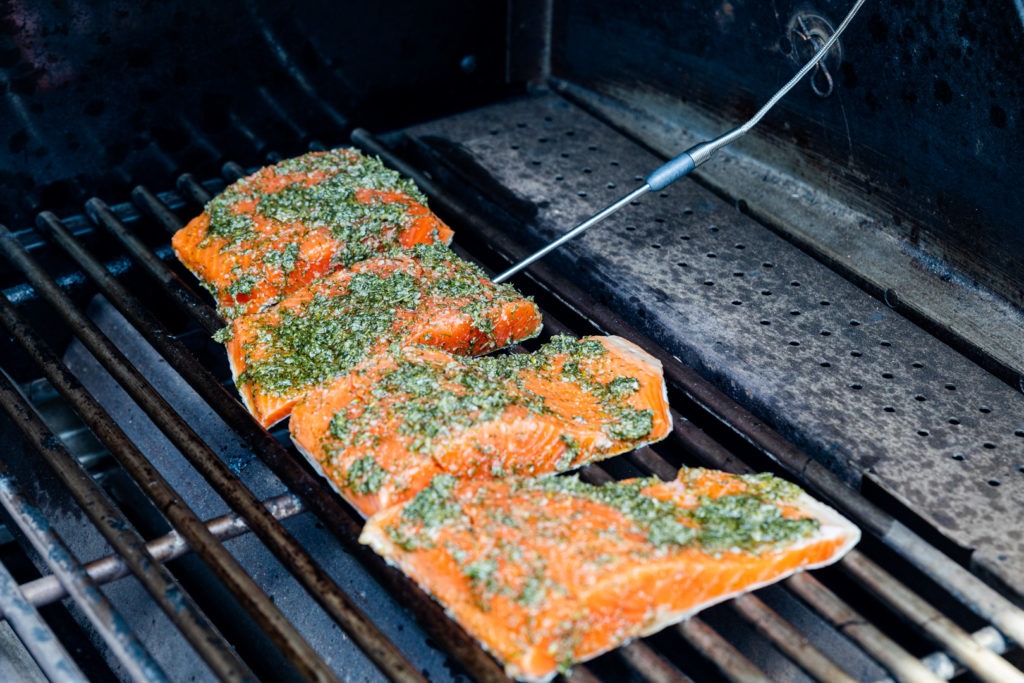
Salmon doneness temp: 140°F
Now that summer is here, the most popular way to cook salmon is definitely to grill it. But if you’ve ever been disappointed with dried-out grilled salmon, you’re not alone! Salmon seems to go from underdone to chalky and sour tasting in the blink of an eye on the high heat of a grill.
Today we’re bringing you a great technique for grilling salmon from Susie Bulloch of HeyGrillHey. It’s flavorful, succulent, flaky and, if you follow our temperature tips, perfectly cooked.
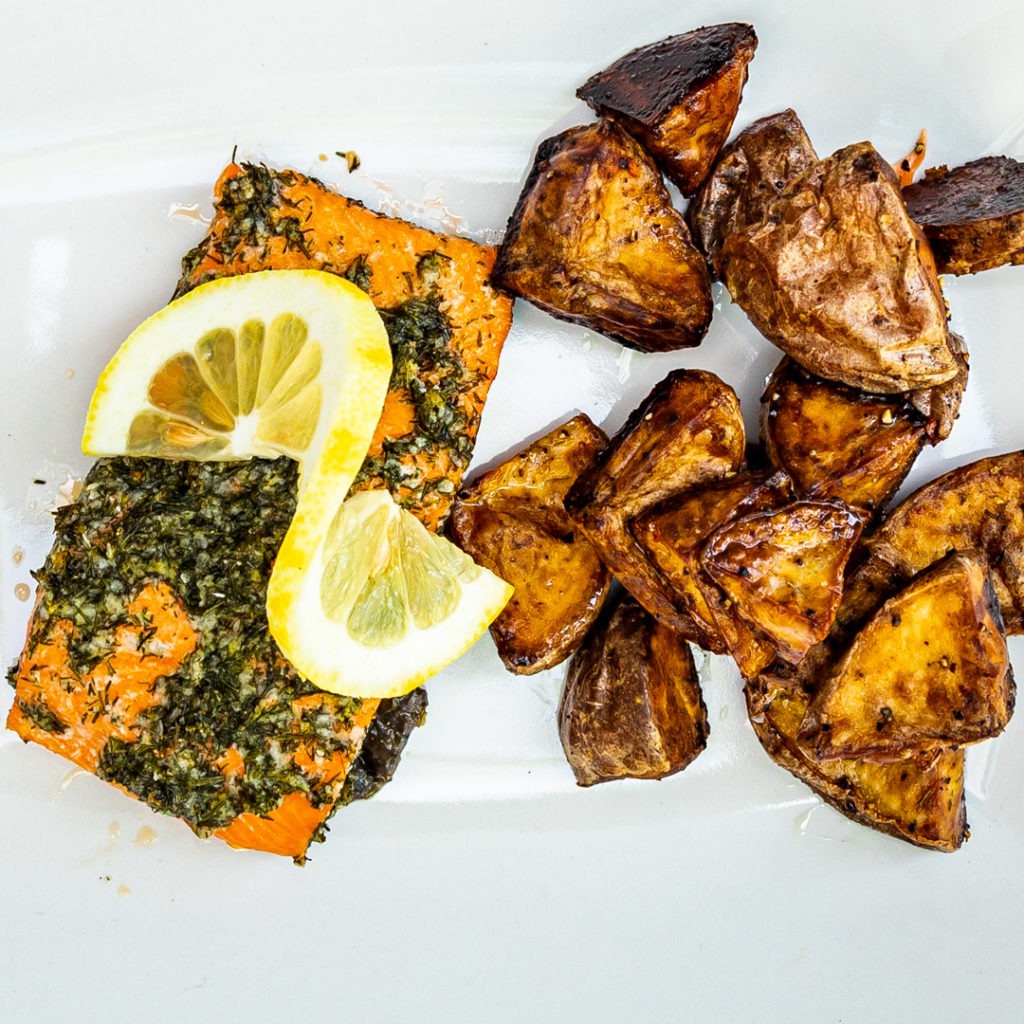
Problems with grilling salmon—or any other fish!
There is no doubt that grilled salmon is a delicious dish, but grilling fish is fraught with problems. The problem partly lies in the temptation to heat up your grill until it’s blazing hot and toss on your salmon fillet. But because of how easily fish dries out, that method often ends up as sad, overcooked fish.
Fish myosin and its fellow fiber proteins are more sensitive to heat than their land-animal counterparts. Where meat begins to shrink from coagulation and major fluid loss at 140°F/60°C, most fish shrink at 120°F/50°C and begin to become dry around 140°F/60°C…. In practice, it’s all too easy to overshoot the ideal temperature range for fish.
—Harold McGee On Food and Cooking, pp 209–211
But drying isn’t the only problem. Salmon can also easily be ruined by the skin or flesh sticking to the grill. Not only does this ruin your fish’s presentation, but not being able to get the fish free from the grill to turn it over or even serve it makes overcooking more likely as you struggle to free the flesh without mangling it.
A note on salmon doneness temps
The USDA recommends cooking salmon to a this-fish-is-dry temperature of 145°F (63°C) for food safety. However, most chefs recommend cooking salmon to a much lower temp, 125°F (52°C). If your salmon has been previously frozen (as much of it is), that low temp is amazing and will yield a custardy, silky-textured fish. However, fresh, never-frozen salmon often has roundworm parasites in it that you want to be sure to kill before eating, and that’s where the higher USDA temp comes into play. This creates a sad paradox, wherein you should overcook fish you have just caught, but fish you bought at the grocer is fine to cook to a lower, better temp. The fish we used in this recipe was fresh, never-frozen, so we cooked it to a higher temperature.
The fish grilling solution: indirect heat
Flaky, tender fish is obviously our goal. Susie Bulloch suggests a great method for grilling it without the drying or the sticking.
It turns out that indirect heat is one of the easiest ways to get your grilled fish just right. By cooking the fish indirectly, you have a better shot of hitting the 135–140°F (57–60°C) pull temperature that is so important.
Of course, you’ll actually need to know what temp the fish has reached, so use a leave-in probe thermometer like the ChefAlarm® to track the cook and alert you when the pull temp is reached. Of course, checking the final temp with an instant-read like the Thermapen® is essential to make sure you get the doneness just right.
As for the problem of the skin sticking, by cooking the fish more gently, the proteins in the fish skin will coagulate more slowly, thus gripping the metal of the grill less tightly. And if it does stick a little, it won’t burn in the time it takes you to get it free.
Of course, if you scrub and oil your grill grates before you cook the fish you’ll be even more likely to avoid sticking.
Seasoning salmon
Salmon’s rich flavor plays well with so many flavors. It’s great brushed with teriyaki sauce, amazing with just salt and pepper, and fun with barbecue sauce. And by all means, use any of those flavors for this technique!
But for this recipe, in particular, we go super classic with lemon zest and dill (already good friends with each other) blended together with a hint of garlic in a bath of olive oil. This paste is smeared all over the meat of the fish, imparting deep, bright flavor that just sings of summertime.
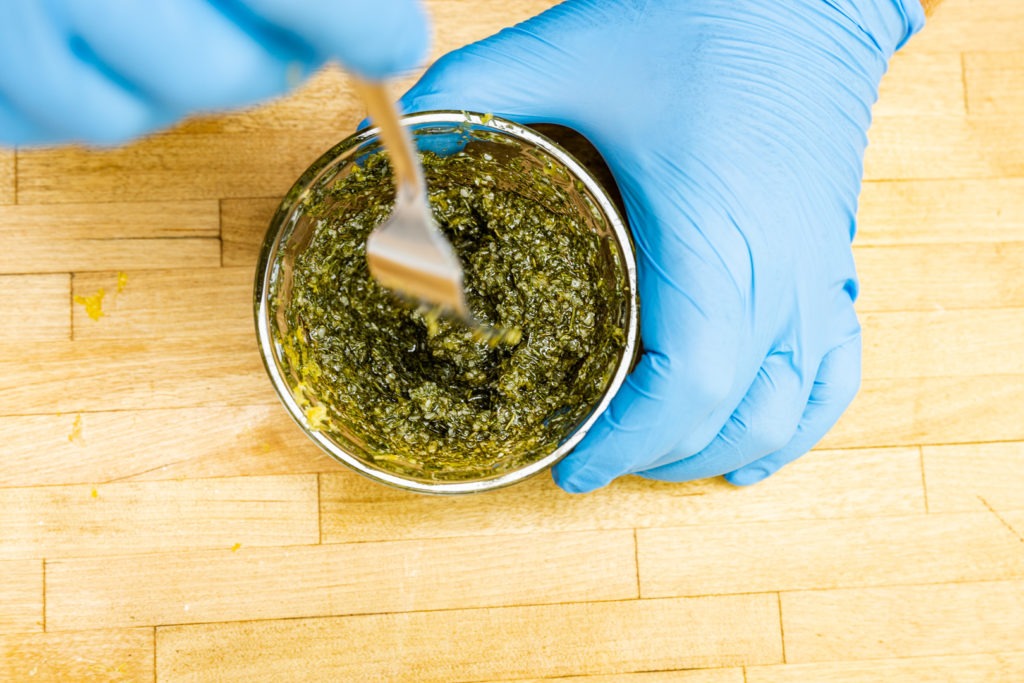
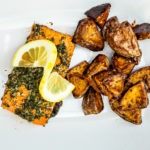
Grilled Salmon Recipe with Dill and Lemon
Description
Based on the recipe from HeyGrillHey.com
Ingredients
Instructions
- Preheat your grill for indirect cooking.
- Clean and oil the grates on the indirect side of the grill well.
- Make the seasoning for the fish by combining the oil, dried dill, salt, pepper, garlic powder, and lemon zest in a bowl.
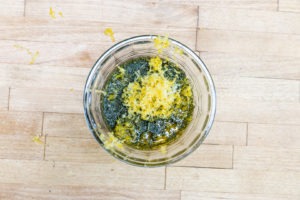
- Rinse each filet in running water and dry them with paper towels.
- Rub the seasoning paste all over the meat of each filet, but not on the skin.
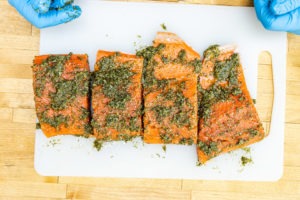
- Place the fillets, skin-side down, on the indirect side of the grill.
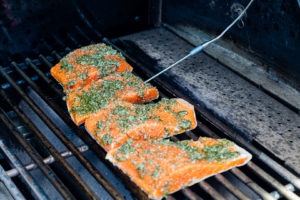
- Insert the probe from a leave-in probe thermometer into the thickest part of one of the fillets. Set the high-temp alarm to 140°F (60°C). Note: be sure the cable for the probe doesn’t hang over the hot side of the grill.
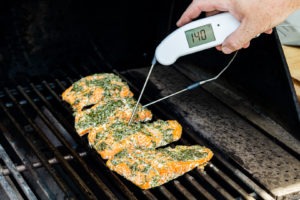
- When the alarm sounds, verify the temperatures with a Thermapen Mk4.
- Serve!
Notes
If you want to pull the salmon a few degrees early and move it over to the hot side of the grill to get some grill marks on it, you can, but watch it carefully and check it often with your Thermapen.
If you love grilled salmon but are tired of your fish coming out dry or sticking to the grill, this indirect method may be a game changer. The temperature-monitoring capabilities of a leave-in thermometer like the ChefAlarm coupled with the gentler heat of indirect cooking can turn out amazing results every time. And with this seasoning paste, you’ll love it even more.
Shop now for products used in this post:
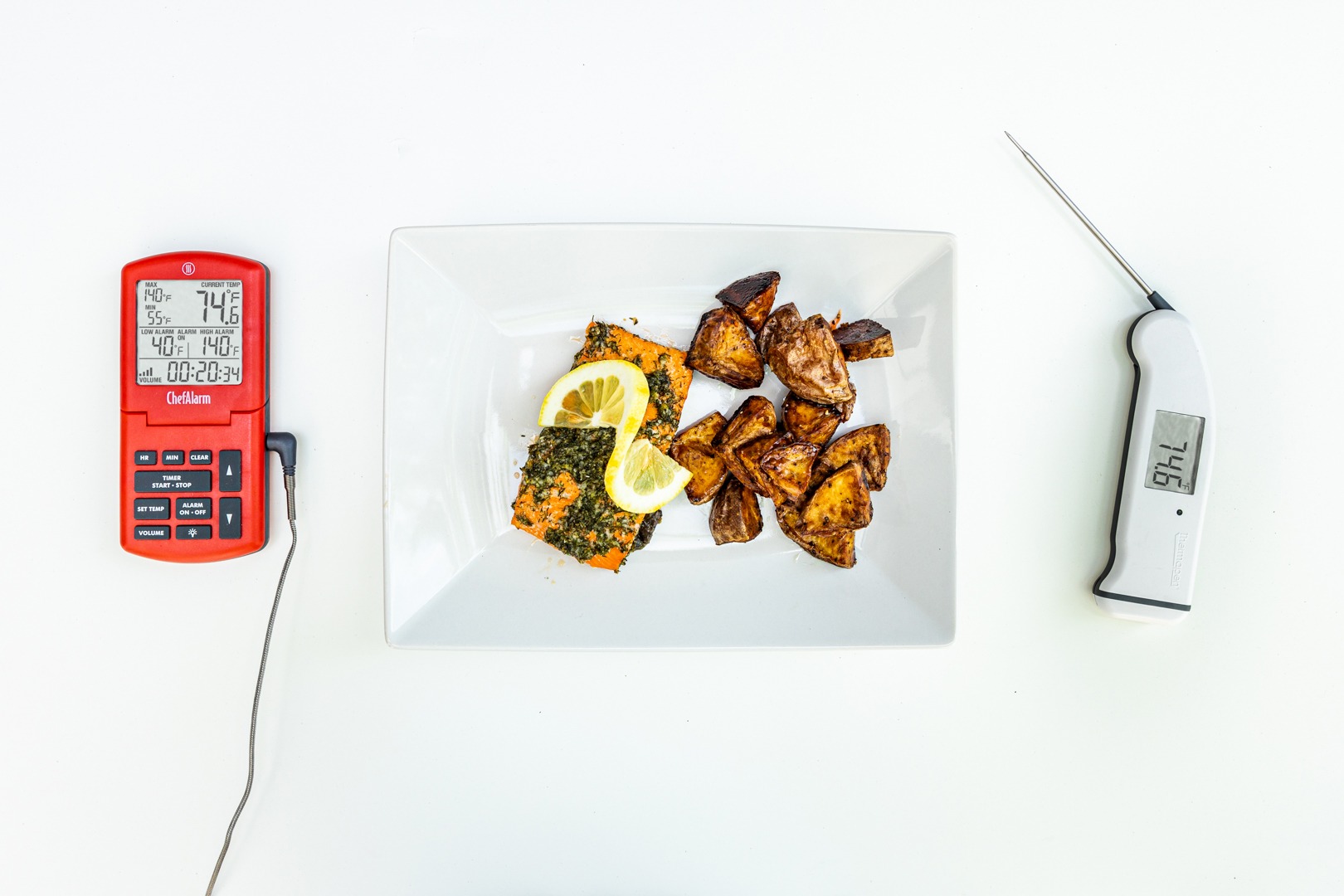
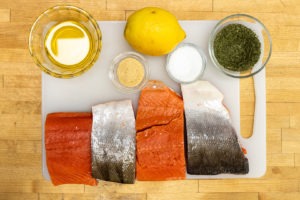

James says
Using cedar planks also moderates the grill heat resulting in more uniform heating and imparts a Smokey cedar character. I also smear some mayonnaise on the flesh side to achieve added browning and a micro thin crust on the flesh. I grill salmon weekly and it is my favorite fish too.
Martin says
Sounds great!
Rick Hsug says
Try brown sugar plus Italian oil dressing as a marinate . Then grill
Michael Facchiano says
what is the suggested Grill Temp?
Martin says
Between 325° and 350°F.
Stanley Cesark says
I like having salmon on the grill but it can be fussy. I never thought of trying indirect method but will give this a shot.
D SoCal Cook says
Great recipe!
I’d add that it is also important after rinsing the filets and before drying them, to give them a quick soak in some water that has some lime or lemon juice in it to remove any surface bacteria on it. I think of it as chemically etching the surface of filets to expose fresh fish.
Fresh is Best…
Gary Walker says
Finished temp too high. 125 deg.max. Needs brining first. Sauce looks good however.
Donald Bronec says
At what temp is the grill set for and do you close the lid?
Martin says
Between 325° and 350°F, and yes, you must close the lid for indirect cooking.
Jake says
I’ve grilled salmon using the same ingredients though varying the amounts & it’s quite good. Another option so you can grill salmon over direct heat like charcoal so as to get that flavor into your food (red Hot charcoal, completely lit) is to use a disposable aluminum grill liner. I have and use KT’s Clean BBQ purchased from Amazon
All I do is spray the grill liner’s surface with Pam olive oil spray, then I place my salmon on the grill liner then place both on the grill over white hot charcoal. Finished temp & time is dependent on the distance between the charcoal and your grill surface. Another factor is the thickness of your salmon
Using the above strategy I remove the salmon and grill liner with a metal spatula once done. You’re now able to easily slide the spatula between the skin and the fish to plate. The grill liner is disposable, no clean up there
One more tip: I like to spread a thin layer of mayonnaise on top of my salmon before seasoning. My favorite salmon seasoning? Lawry’s Seasoning Salt and fresh ground black pepper. Others may have better and different ideas
Al says
Sounds great. What is the recommend grill temperature for cooking the salmon.
Martin says
Between 325° and 350°F.
Dan Cerys says
The 140 degree temperature recommendation conflicts with the 125 degree temperature on your own web site (see Fish and seafood temperature guide) and my own experience/preference.
Martin says
Dan,
Good catch. We went with a piece closer to the USDA for this recipe, as it was the recommendation of the recipe we were borrowing from. Salmon cooked medium rare is truly a treat, but if getting it fresh, never frozen, I often cook to 140°F to kill off any worms that won’t have been taken care of by freezing.
Nina says
I am have also been under the impression that wild caught salmon is done at
125F especially since its flesh is more lean than farm raised salmon.
140F for wild caught salmon is way over done in our option and experience.
Again this new temp of 140F for salmon conflicts with your past website temp of 125F
Other fish yes 140F…. not wild caught salmon.
Dal Graham says
I learned this in Alaska:
Grill your salmon indirect, skin side down.
When bottom side done slip spatula between skin and meat and flip meat placing it back on the skin.
Continue cooking until meat done.
The cooked skin is a real treat for the dogs who are always standing by.
Your dressing would be great
Gene Nandrea says
What would be the recommended grill temperature for a Big Green Egg using the Smoke?
Martin says
Between 325° and 350°F.
Steve says
What temp is ” preheat the grill for indirect cooking”?
Martin says
You want a temperature on the indirect side to be between 325°F and 400°F, shooting for around 350°F.
Arnie Chase says
Olive oil the skin and using a perforated and oiled tray makes it easy to move fish on and off grill. Cooking slow at 225 degrees on my Traeger works best for me. Season with lemon pepper, Johnny’s Garlic Spread & Seasoning, and chopped onions.
I have always forked thickest piece of whole fallet Salmon but will now after reading this article, thanks, will use my Thermoworks to verify my fork method which always comes out perfect but will allow me to relax more when the Salmon gets close like with other meats. Cooking indirect or low heat on pellet stove works great for Salmon!
Love your products and articles!!!
George says
The best Salmon is Copper River. It has a short season and cost a bit more. The best and only way to cook Salmon is on a cedar plank over direct heat. Soak the cedar plank for an hour or so. place the Fillets on the plank and season your favorite way and let cooking begin.
Connie says
Am I reading this right? One tablespoon of pepper?
Martin says
1 tsp! Fixed it.
Wendell McQueary says
Another way to do your salmon over indirect heat is. Place salmon skin side up, spray with non-stick cooking spray, turn over & cover with a hickory-honey mustard thinned down with a little bit of white wine to a pourable (think cheese sauce) thickness. Place on grill (or even in the oven at 325) skin side down cook to temp of 130. Sprinkle with chopped flat-leaf parsley, serve with lemon wedges.